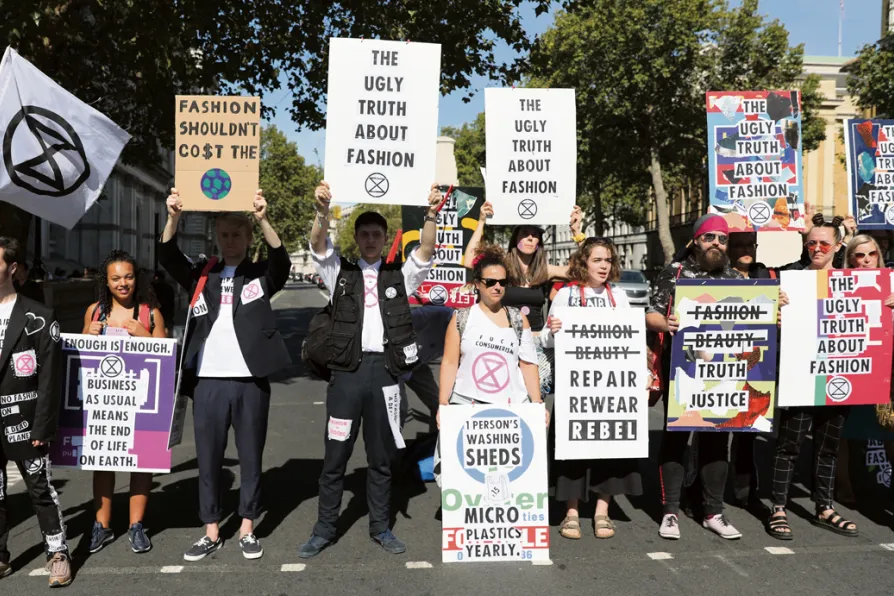Durham Miners’ Association general secretary ALAN MARDGHUM speaks to Ben Chacko ahead of Gala Day 2025

 NOW OR NEVER: Protesters from Extinction Rebellion demonstrate outside the Foreign and Commonwealth Office in London, last week, ahead of the Victoria Beckham Spring/Summer 2020 London Fashion Week catwalk show
NOW OR NEVER: Protesters from Extinction Rebellion demonstrate outside the Foreign and Commonwealth Office in London, last week, ahead of the Victoria Beckham Spring/Summer 2020 London Fashion Week catwalk show
A YOUNG and stylish woman friend of mine, and incidentally a fan of my weekly Ramblings, was telling me about what she is doing personally to reduce the effect of climate change. She has adopted a fully vegan diet and doesn’t buy any new clothes at all except for knickers.
She buys all her clothes from Charity shops like Oxfam: “Oxfam are particularly good and also have a website where you can buy quite stylish items by mail order.”
She explained why charity shop purchases are so much part of her political thinking: “The fashion industry is a disaster. Fast fashion focuses on speed and low costs in order to deliver frequent new collections inspired by catwalk looks or celebrity styles.
“This is particularly bad for the environment, as pressure to reduce cost and the time it takes to get a product from design to shop floor means that environmental corners are likely to be cut.
“Just as important, so much of the fashion industry is based on sweatshop factories all over the Third World. It is a huge greedy industry from sweatshop to high street fashion chains and websites.
“If the fashion business is bad, much worse, especially when it comes to climate change, are the industries making the raw materials that the rag trade uses to make next week’s high-street fashion offering.”
About here Frosty needs to declare an interest. My wardrobe, such that it is, is almost entirely made from cotton. My shirts, knitted shirts, cords and even underwear are almost all made of 100 per cent cotton.
You can see, I like cotton but as you are about to read I’m beginning to realise I’m part of a major problem when I usually try to be part of the solution.
Of course I have always known that cotton has some dark secrets in its long history. British slavers raided the coast of Africa to kidnap slaves to work the cotton fields of the US southern states.
The “dark satanic mills” of Lancashire and indeed of New England in the US saw some of the worst and most dangerous working conditions, all to produce what became known as King Cotton.
These cotton mills saw many battles as workers began to organise and take on the capitalist mill owners, some of the most cruel, greedy and grasping in the world.
Friedrich Engels wrote much about them and so did his best mate Karl Marx. Engels’s father actually owned a textile factory in Salford making Friedrich quite the expert.
Textile dyeing is the second largest polluter of clean water globally, only agriculture is worse
In the cotton mill towns of New England across the Atlantic the massive red brick mills look almost exactly the same as those in Lancashire. One, in Lawrence, Massachusetts, was the site of the famous 1912 Bread and Roses strike — a strike that featured mainly female workers — about which I have written in these pages.
Today cotton is causing massive environmental damage which is causing environmental disaster after environmental disaster all over the globe.
One of the worst examples is the former Aral Sea, between Kazakhstan and Uzbekistan, once one of the largest bodies of fresh water in the world, now reduced almost entirely to dust as a side effect of the cotton industry.
Once the fourth-largest lake in the world, it has been shrinking since the 1960s. The rivers that fed it were diverted by cotton irrigation projects for the vast Soviet cotton industry.
By 1997, the sea was just a tenth of its original size and satellite images in August 2014 revealed that the eastern basin of the Aral Sea had completely dried up. That eastern basin has become the Aralkum Desert.
A Kazakh dam, started in 2005 to save and replenish the North Aral Sea is having some effect. By 2008, the water level in the lake had risen by 12 metres (39ft).
The Aral Sea is just one of the many locations all across the globe. New dust bowls are appearing across what were once rich cotton prairies in the southern states of the US too.
Across the world too, toxic chemicals used for growing cotton have led to health problems. They range from the death of a US cotton farmer from a brain tumour to serious birth defects in Indian cotton farmers’ children.
Today most cotton grown worldwide is genetically modified to be resistant to the boll weevil but at last there is growing interest in organic cotton. Sadly so far this only represents less than 1 per cent of the world’s cotton. We clearly have a long way to go.
Not all fashion garments are made from cotton. More and more are made of polyester. Today this is the most popular fabric used for fashion.
The fashion industry constantly seeks to invent new vibrant colours, prints and finishes. These can only be achieved by higher levels of toxic chemicals. Textile dyeing is the second largest polluter of clean water globally, only agriculture is worse.
Greenpeace has been pressing fashion brands to take action to remove toxic chemicals from their supply chains, after it tested a number of brands’ products and confirmed the presence of hazardous chemicals.
Many of these are banned or strictly regulated in various countries because they are toxic. They are bio-accumulative — a term meaning the substance builds up in an organism faster than the organism can excrete or metabolise it. They are also disruptive to hormones and carcinogenic.
Even at home when polyester garments are washed in domestic washing machines, they shed microfibres that add to the increasing levels of plastic in our oceans.
These microfibres can easily pass through sewage and wastewater treatment plants into our waterways. They do not biodegrade and because of this they represent a serious threat to aquatic life.
These microfibres make their way up the food chain from plankton to bigger fish and shellfish and eventually to our fish and chips suppers.
MPs in an environmental audit committee (EAC) report published at the end of last year recommended that fast fashion companies should be forced to act on cleaning up the notoriously dirty industry.
Amongst the proposals was a charge of 1p for each garment produced to raise £35 million to fund clothing recycling.
Our Tory government and new unelected Prime Minister Boris Johnson has totally rejected the proposals despite the general public’s sympathy and support for what are fairly humble demands.
Once again Tory ministers are completely out of step with serious environmental issues arising from throwaway fashion.
Clearly our clothing industry has a big problem and one that is getting worse. So is there anything you can do? A new charity Wrap has launched The Love Your Clothes initiative to give advice on buying more responsibly, caring for and repairing clothing items, up-cycling and responsible disposal.
Ultimately, the best thing we can do is to keep our clothing in use for longer, buy less new stuff and even more important, keep up the wider pressure to reverse the many disasters and unsustainable actions that are causing climate change.



















